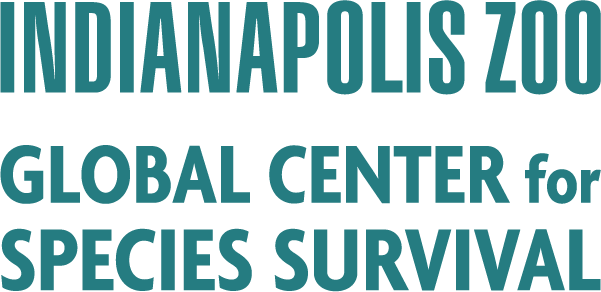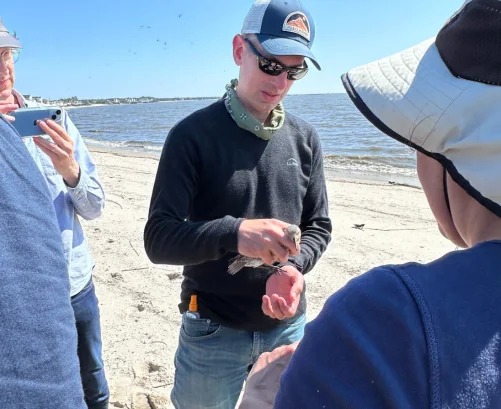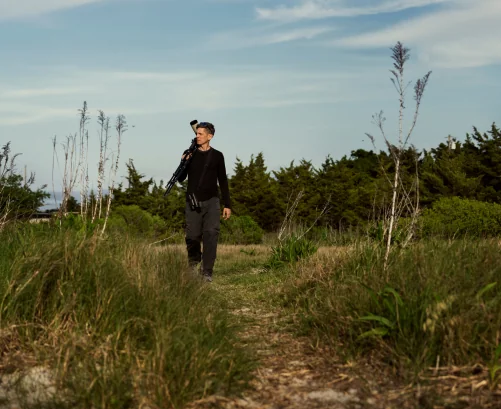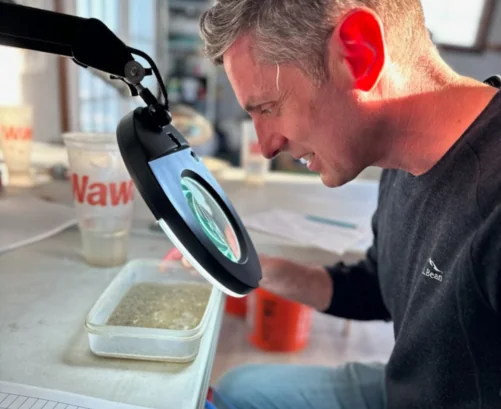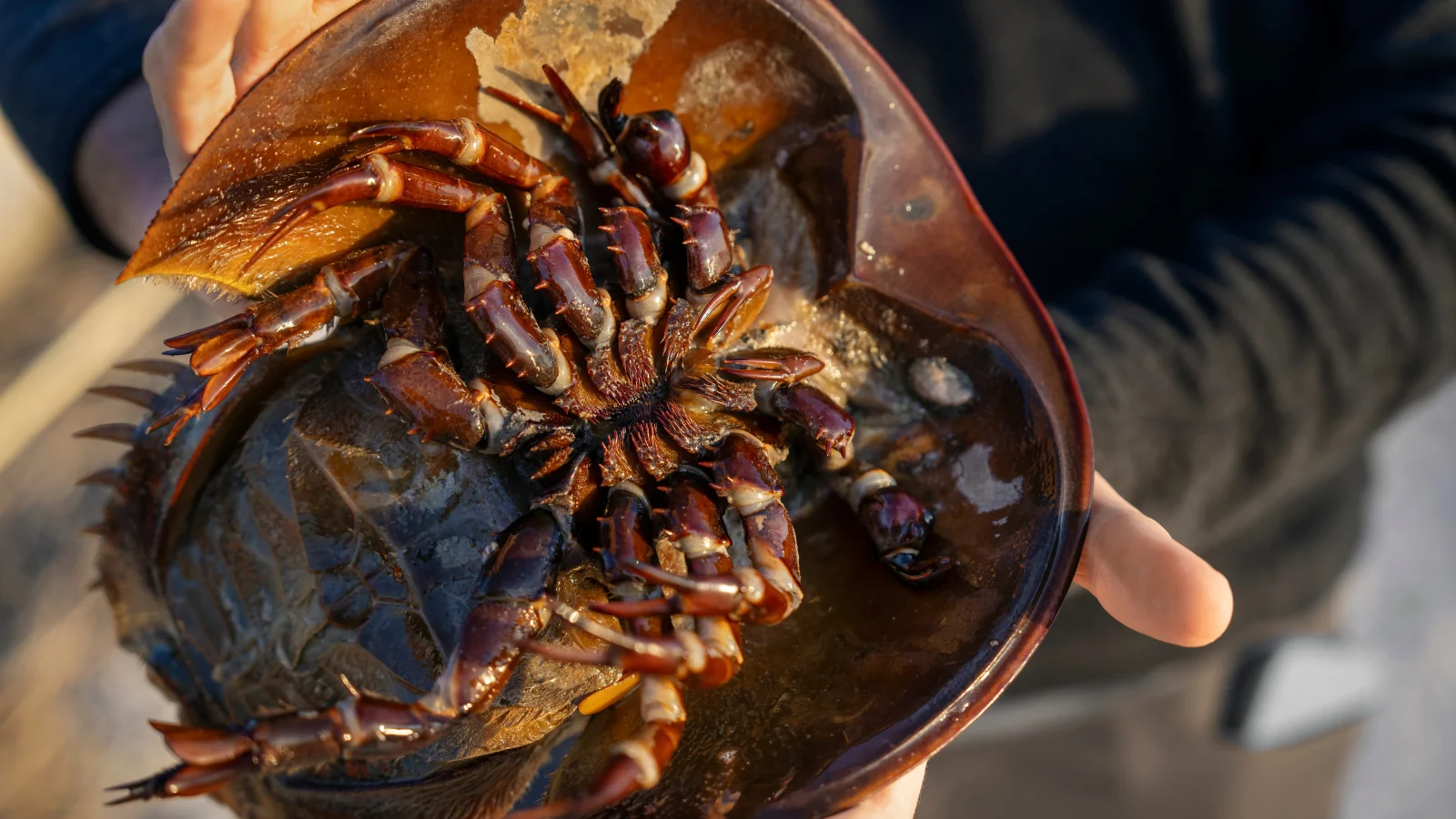
Helping Horseshoe Crabs
How Horseshoe Crabs Help Humans
What do life-saving vaccines and medical devices have to do with horseshoe crabs? Well, you can thank those marine arthropods for your health and safety! To better understand the process of using blue horseshoe crab blood in the biomedical industry and how that process impacts horseshoe crab populations, we interviewed Jay Bolden.
Jay is a scientist and avid birder turned conservationist. As senior director at the pharmaceutical giant Eli Lilly and Company, Jay has spent more than a decade working tirelessly to turn the tide (pun intended) on drug industry standards—to phase out the use of horseshoe crab blood and switch to a synthetic substitute.
We enjoyed getting to know Jay through our work with the IUCN SSC Horseshoe Crab Specialist Group. The Indianapolis Zoo funded the 5th International Workshop on Science and Conservation of Horseshoe Crabs in Singapore in July of 2024, and Jay was an invited speaker.
What are Horseshoe Crabs?
Before we get to our conversation with Jay, let’s talk about horseshoe crabs in general. Marine chelicerate arthropods are more closely related to spiders and scorpions than true crabs. (Chelicerae refers to pincer-like specialist mouthparts.) Horseshoe crabs are closely related to extinct sea scorpions, one of the largest arthropods that ever lived, reaching 8.2 feet! There are four extant (or living) species: American horseshoe crab (Limulus polyphemus), tri-spine horseshoe crab (Tachypleus tridentatus), mangrove horseshoe crab (Carcinoscorpius rotundicauda) and coastal horseshoe crab (Tachypleus gigas).
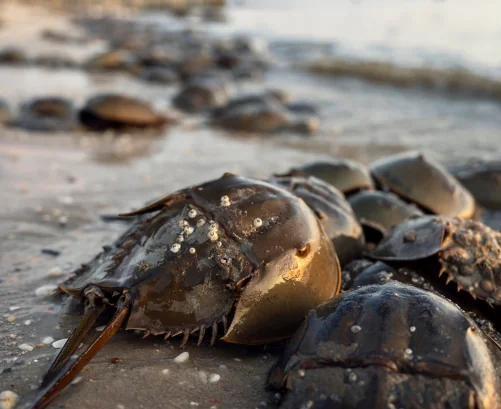
What Role Do Horseshoe Crabs Play in Nature?
These “living fossils” can be found in shallow, coastal water on soft sandy or muddy bottoms, spawning mostly on intertidal beaches. This breeding behavior is part of what makes horseshoe crabs so important. They play a significant role in marine and coastal ecosystems, largely because of their position in food webs. Their energy-rich eggs serve as an essential food source for migratory shorebirds. Declining populations of migratory shorebirds such as red knots along the Atlantic flyway have been linked with declining horseshoe crab populations.
However, horseshoe crabs aren’t just food for other animals. Horseshoe crab activities help to enhance habitats for various organisms such as worms, small crustaceans and other benthic (bottom-dwelling) species. Plus, horseshoe crab exoskeletons provide additional resources to the environment, such as habitat and food for decomposers and other marine species.
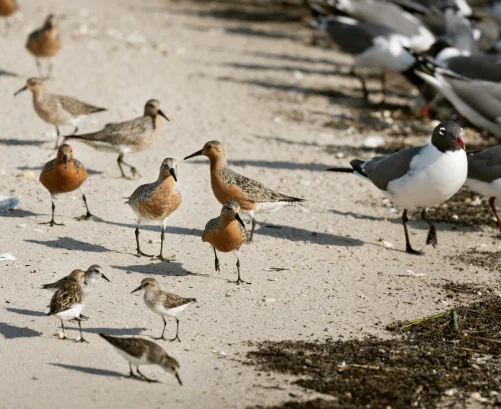
What’s the Conservation Status of Horseshoe Crabs?
We talked with the IUCN SSC Horseshoe Crab Specialist Group to get more information about the conservation status of these incredible invertebrates, and horseshoe crabs face threats similar to other marine species. The four extant species of horseshoe crabs are imperiled due to threats such as overfishing for use as food and bait; harvesting for the production of biomedical products derived from their blood; and habitat loss or alteration due to shoreline development and armoring against coastal erosion.
Currently on the IUCN Red List of Threatened Species, horseshoe crabs are assessed as follows:
- Mangrove Horseshoe Crab (Carcinoscorpius rotundicauda) is Data Deficient (DD)
- Coastal Horseshoe Crab (Tachypleus gigas) is Data Deficient (DD)
- American Horseshoe Crab (Limulus polyphemus) is Vulnerable (VU)
- Tri-spine Horseshoe Crab (Tachypleus tridentatus) is Endangered (EN)
So, what can be done to help horseshoe crabs? We turn to Jay for answers and a greater understanding of how these amazing creatures help keep humans healthy.
Our Conversation with Jay Bolden, Senior Director at Eli Lilly and Company
What is special about horseshoe crab blood?
Horseshoe crab blood, believe it or not, has protected human health for at least 45 years. It is a beautiful royal blue color because it is copper-based compared to our iron-based human blood.
How has horseshoe crab blood been used, historically?
The crab blood contains the cells that defend the crab against bacterial contamination in its environment. Drs. Frederick Bang and Jack Levin observed this in the 1950s and 1960s, and from this observation, Dr. Jim Cooper developed a test for bacterial contamination, specifically for the toxic part of the bacterial cell wall, or endotoxin.
How is horseshoe crab blood collected and how does the collection process impact the crabs?
Horseshoe crabs in the United States are impacted by humans in two ways – they are collected by hand or by trawling, and are used for bait to catch eel and conch, which are also threatened species, resulting in 100% mortality. They are also used in the biomedical industry for the bacterial endotoxin test – a portion of their blood is collected, and they are returned to the water. This is not meant to be lethal, although there is some associated mortality in the process. The collected blood is further processed to purify the specific cells into a laboratory test reagent called Limulus Amebocyte Lysate (LAL) that detects bacterial endotoxins in medicines, manufacturing processes and medical devices – anything that is injectable is tested to ensure the safety of the product.
How did you get interested in conservation?
I have been interested in birds for a long time and studied Prothonotary Warblers in undergraduate ornithology field research at Indiana University. I have enjoyed birding as a hobby for about as long as I have been working at Lilly – it is my excuse to get outside. Like a lot of outdoor pursuits, eventually you can find opportunities to give back. Making the connections between my professional life and personal passion for birding has enabled education opportunities to bridge two otherwise unconnected communities.
Is there a synthetic alternative to horseshoe crab blood?
There is! It is called recombinant Factor C (rFC) and was discovered by Dr. Lynn Ding at the University of Singapore in the 1990s. It is created from similar biotechnology processes that Lilly has used for over 40 years to make insulin, for example. Factor C is the name of the natural blood protein in the horseshoe crab, so rFC is a synthetic copy of that protein that has been shown to be equivalent or superior to LAL. More recently a second synthetic alternative called recombinant cascade reagent (rCR) was developed – think of it more like synthetic LAL, so there are several options available to which current LAL users could transition and reduce their impact on nature.
What is Lilly doing to reduce the need for collected horseshoe crab blood?
We have converted about 80% of our endotoxin testing from LAL to rFC. In 2018, we achieved a first-in-industry approval to test a medicine using rFC instead of LAL, and now have 10 products approved using rFC. We implemented rFC in 11 manufacturing sites around the world and at 13 partner manufacturing or laboratory sites to date. We have been very open about our efforts, our data, our successes and setbacks in an effort to show our industry peers that it can be done and there are positive benefits to doing so.
You have developed some best practices using synthetic alternatives that don’t require the collection of wild horseshoe crabs. How can we encourage other pharmaceutical companies to adopt these practices?
The barriers are falling – globally there are national test methods that specified the use of LAL. New methods in Europe (2021), the U.K. and the United States (2024) specify the use of synthetic alternatives. Adopting the recombinant reagents will benefit companies from a quality, supply chain security, ethical and likely cost benefit. I have seen good momentum in especially the last two years with several big pharmaceutical companies converting their testing or openly discussing plans to change. We should all continue to be cognizant of the potential negative impacts we have on nature and focusing on making positive changes within our control.
What more can be done to save horseshoe crabs from extinction?
Adoption of synthetic alternatives in the pharmaceutical industry is not the singular fix for negative human impacts on the horseshoe crab, but it is a positive impact and it is something within the pharmaceutical industry’s control. Mortality due to bycatch and bait are significant, as is habitat loss. You can support the issue – check out the Horseshoe Crab Recovery Coalition and their many partners, the Ecological Research & Development Group and the IUCN SSC Horseshoe Crab Specialist Group. Remember the interconnectedness between species – this isn’t just about horseshoe crabs, but red knot shorebirds, turtles, sport fish, etc. If we can help one species, we are positively impacting overall biodiversity. Go change something in your control!
This blog was a collaboration between experts at the Global Center for Species Survival, including Marine Conservation Coordinator Coralie Palmer, Invertebrate Conservation Coordinator Dr. Sérgio Henriques and Bird Conservation Coordinator Dr. Sam Ivande.
Our thanks to Jay Bolden and Eli Lilly and Company for their time and expertise.
All photos in this blog post were taken by photographer Todd Rosenberg and are the property of Eli Lilly and Company.
Published March 21, 2025
